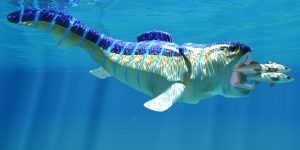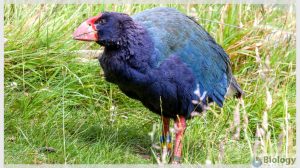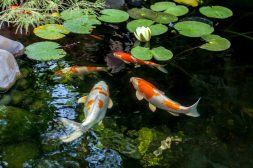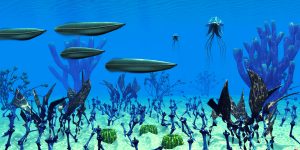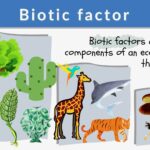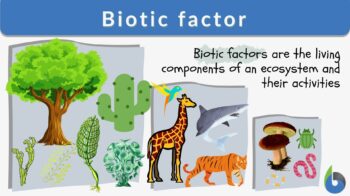
Biotic factor
n., plural: biotic factors
[baɪˈɑ.tɪk ˈfæktə]
Definition: any of the living things or their activities in an environment
Table of Contents
Biotic Factor Definition
A biotic factor is the living component in an ecosystem. The term “biotic” means “of or related to living organisms”. An ecosystem consists of all living organisms and the physicochemical components. They are also referred to as the biotic factors and abiotic factors, respectively. They interact and function together as a unit.
The abiotic factors include the physical and chemical factors, such as sunlight, water, temperature, and other non-living components of an ecosystem. Biotic factors are the living components, such as bacteria, birds, and any other living things present in an ecosystem. This article is focused on the biotic factors that shape an ecosystem.
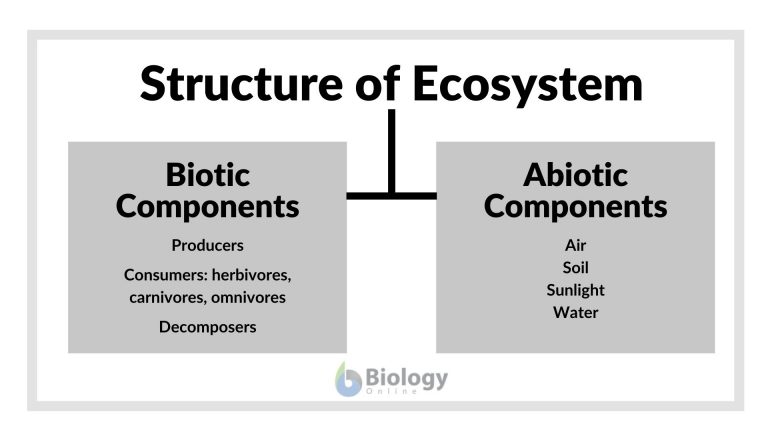
Biotic factors are defined as the living components or factors that affect an ecosystem or other organisms living in that ecosystem. Bacteria that live inside the intestine of an animal act as biotic factors that have acquired the role of helping with the proper digestion of the food in the intestine.
Another example is the population of zebras, antelope, or other animals, which are the biotic factors for lions that hunt and consume them for the latter’s survival. A disease-causing virus is also a biotic factor that can affect animal and human populations by causing disease, especially on a large scale. Apart from the disease-causing (pathogen) microbes, biotic factors may also include parasites, predators, symbionts, prey, and competitors.
A biotic factor is a factor created by a living thing or any living component within an environment in which the action of the organism. Biotic factors are factors resulting from the activities of a living thing or any living component in an environment, such as the actions of an organism affecting the life of another organism. For example, in a quail’s environment, the biotic factors are the living elements of the environment such as the quail’s prey (e.g. insects, seeds, etc.), and the quail’s predators (e.g. coyotes). Etymology: biotic, from the Ancient Greek βιωτικός (biōtikós), meaning “of life”, from βίος (bíos), meaning “life”) + -ic. Compare: abiotic factor
Role of Biotic Factors in an Ecosystem
The interaction between animals in an ecosystem shapes its environment. In a river or sea, the biotic factor examples include fish, aquatic plants, algae, and amphibians. Both the biotic and abiotic factors play their role to create a unique ecosystem.
As it is clear now that the biotic factor refers to a living thing, thus it is obvious that they need a certain amount of energy, food, and environment to function properly. They get their energy and nutrition from their environment. In an ecosystem, it is common that one biotic factor is dependent on another biotic factor to survive. For example, a deer itself is the biotic factor for predators, however, it depends on plants for survival.
Plants are also biotic factors in an environment. Their dependency, however, on other biotic factors, in terms of food is not as extensive as the animals that hunt and prey. They produce their own food by photosynthesis. Nevertheless, plants require CO2 for food production that they derive from natural sources, including from animals that breathe it out during exhalation (respiration).
Also, some plants are “carnivorous”, obtaining food by capturing animals (e.g. insects) using a special trapping organ. An example of such a plant is the Venus flytrap. Despite such an extraordinary ability to feed on animals though, these carnivorous plants would still make their own food by photosynthesis. Because plants serve as the producers in an ecosystem, many organisms thrive in habitats abundant in plants.
Nevertheless, other organisms are also found elsewhere not populated by plants. Examples are deep oceans, lava beds, and deserts. Examples of biotic factors in deserts are cactus plants, desert lizards, and snakes.
Exercise: What are biotic factors?
1. Take a look at the diagram below. Can you spot the abiotic and biotic factors? Can you name at least 5 biotic factors?
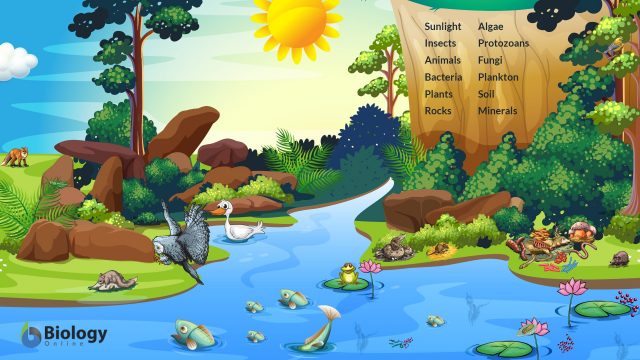
2. How about in this diagram? Can you identify the 10 biotic factors present in this pond ecosystem?
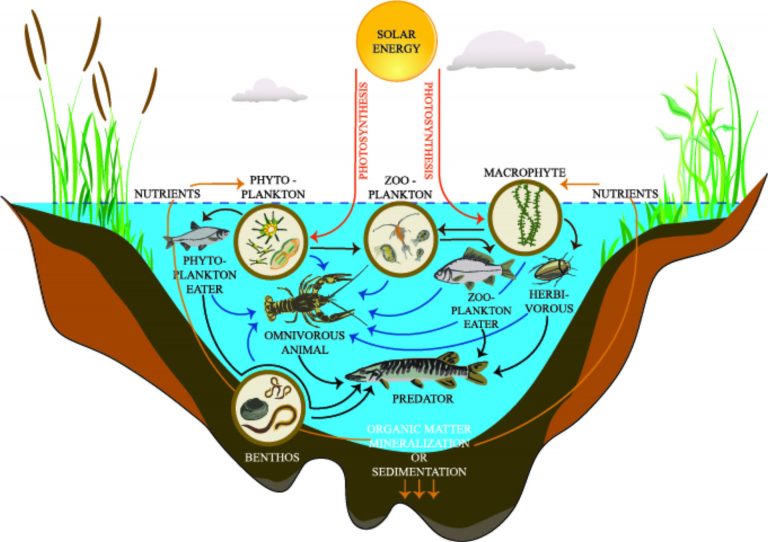
Answer: The biosphere! The biosphere is defined as the sum of all the ecosystems on Earth. Another way to define a biosphere is that it is the living portion of the planet. Thus, the biotic factors are, in essence, one of the distinctive features of the Earth that sets it apart from the other planets.
Types of Biotic Factors
How the biotic factor affects another organism in an ecosystem depends on the type of the biotic factor itself. Biotic factors have been divided into three main categories, which define their distinctive role in the ecosystem:
1. Producers (Autotrophs)
2. Consumers (heterotrophs)
3. Decomposers (detritivores)
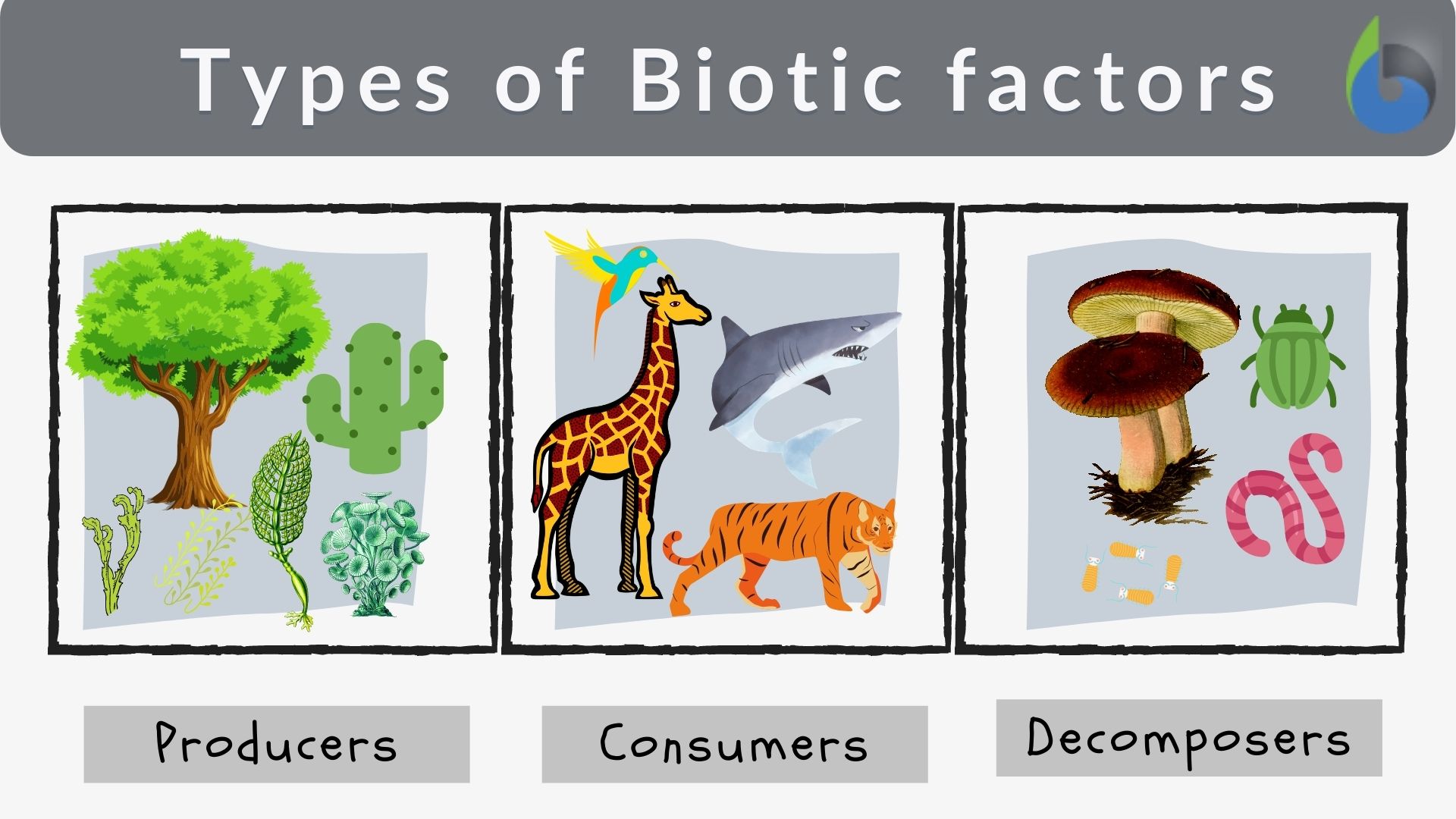
Producer type biotic factors (Autotrophs)
The producers are biotic factors that are very important in an ecological system because these organisms “produce” food from inorganic materials and energy sources. Life may not be able to exist without them. They have the capability to produce complex organic compounds, such as fats, carbohydrates, and proteins using inorganic ingredients, such as water and carbon dioxide. They convert these inorganic molecules into organic compounds by using chemical reactions (chemosynthesis) and light (photosynthesis). In other words, producers store the energy from abiotic sources by converting them into complex compounds, which, in turn, are consumed by other organisms. Plants on land and algae in water are examples. Plants produce their own food from carbon dioxide in the air and water from the Earth.
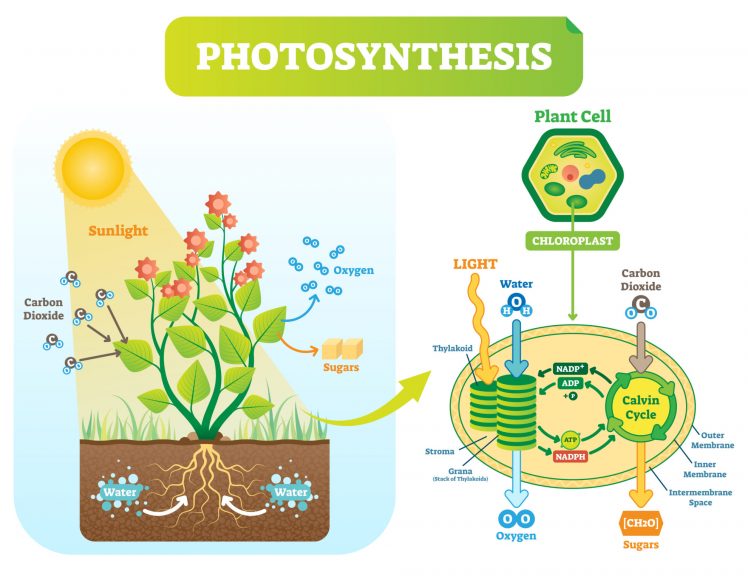
Producers are classified into two major classes:
- Photoautotrophs
- Chemoautotrophs
Photoautotrophs
As the name suggests, photoautotrophs are producers that get their energy from sunlight to produce their food. Photoautotrophs are the most common producers on earth. Their examples include green plants and algae. Photoautotrophs use photosynthesis to convert inorganic compounds into organic compounds. They use chlorophyll pigment (green color) to harness the photons in sunlight. The photoautotrophs then package that energy in the form (sugars, proteins, lipids, fats, etc.) that the other living things can consume.
Many organisms depend on plants to get their energy. Animals that depend on a plant-based diet are called “herbivores”. Carnivorous (meat-eating) animals (e.g. lion, tiger, etc.) that do not directly eat plants but prey on herbivores (e.g. zebras) indirectly depend on plants for their survival. A decrease in the population of prey due to a shortage of plant-based food will eventually affect the population of predators. So these animals indirectly depend on photoautotrophs.
Apart from plants, there are certain bacteria that are also photoautotrophic. Cyanobacteria are prokaryotic organisms that use oxygen and sunlight to carry out photosynthesis. These bacteria are present in almost every environmental condition including soil, freshwater, lichen, and seawater. These bacteria use water as a source of electrons to reduce carbon dioxide during reactions.
Chemoautotrophs
Chemoautotrophs are a type of chemotrophs characterized by the ability of the organisms to synthesize food (organic compound) mainly from carbon dioxide and from other inorganic compounds through the process of chemosynthesis.
Another type of chemotroph is chemoheterotroph (i.e., chemotrophs that cannot fix carbon to form their own organic compounds). The common energy sources include inorganic compounds, such as hydrogen sulfide, sulfur, ammonium, etc. Examples of chemoautotrophs are certain methanogens, which make methane. Methane is a greenhouse gas and a useful fuel as well.
The chemosynthetic process is based on the oxidation of electron donors (hydrogen, iron, sulfur, etc.) in the environment. The chemoautotrophs synthesize their necessary chemical reactions using carbon dioxide as the major source. They can also use inorganic electron sources such as ferrous iron, hydrogen sulfide ammonia, and elemental sulfur. These organisms live in hostile environments such as deep-sea vents.
There are several classes of chemoautotrophs: thermoacidophiles, methanogens, anammox bacteria, sulfur reducers, and oxidizers. The chemoheterotrophs cannot fix carbon to produce their food and rely only on inorganic compounds. One example of such an organism is iron and manganese-oxidizing bacteria. These organisms live in deep oceans and they get their energy needs by oxidizing ferrous ions (Fe+2) to ferric iron (Fe+3).
These organisms are usually found in areas with high ferrous concentrations such as ocean beds and new lava beds. Scientists are still unable to find how the iron bacteria extract iron from the ores. The other source of iron is hydrothermal vents. These vents allow the bacteria to survive on fresh iron.
The magnesium-oxidizing bacteria utilized igneous lava rocks that contain high amounts of manganese in the form of Mn+2 ions. The bacteria convert Mn+2 ions into manganic manganese, i.e. Mn+4. There are two electrons available in this process in contrast with the iron-oxidizing process. Researchers are yet to study manganese-reducing bacteria.
As for the difference between a chemoautotroph and a photoautotroph, the former uses inorganic compounds for food production in the absence of light whereas the latter uses sunlight to energize the process.
Consumer biotic factor (heterotrophs)
Consumers as biotic factors are those that rely on other living organisms as food to obtain energy and survive. They are also referred to as heterotrophs in contrast to autotrophs. The term heterotroph is from the Greek “hetero”, which means “others” and “troph”, which means “food”. The heterotrophs take nutrition from plants or other animals and are unable to make their own food. Humans, for instance, cook their food but cannot make it themselves. We certainly cannot make an onion or potato! We rely on the materials from primary producers for our plant-based diet. Yes, we can help them produce food by providing water, nutrition, and a suitable environment to grow effectively, but we cannot “create” crops naturally.
Consumers include animals, bacteria, fungi, and parasitic plants. Consumer biotic factors are categorized as primary, secondary, and tertiary consumers. They are not producers. The consumers that eat plants are known as herbivores and are categorized as primary consumers.
The ones that eat the herbivores or the grass-eating animals are called carnivores and are categorized as secondary consumers. The ones that eat both plants and animals are called omnivores and they may be secondary or tertiary consumers. The animals that eat the secondary consumers are called tertiary consumers.
So for example, the primary consumer is a rabbit, the secondary consumer is a snake that eats rabbits, and the tertiary consumer is an owl that eats snakes. Examples of herbivore consumers are sheep, goats, zebra, cattle, etc. Examples of carnivores are lions, cats, tigers, hyenas, etc. Examples of omnivores are humans, bears, crows, etc.
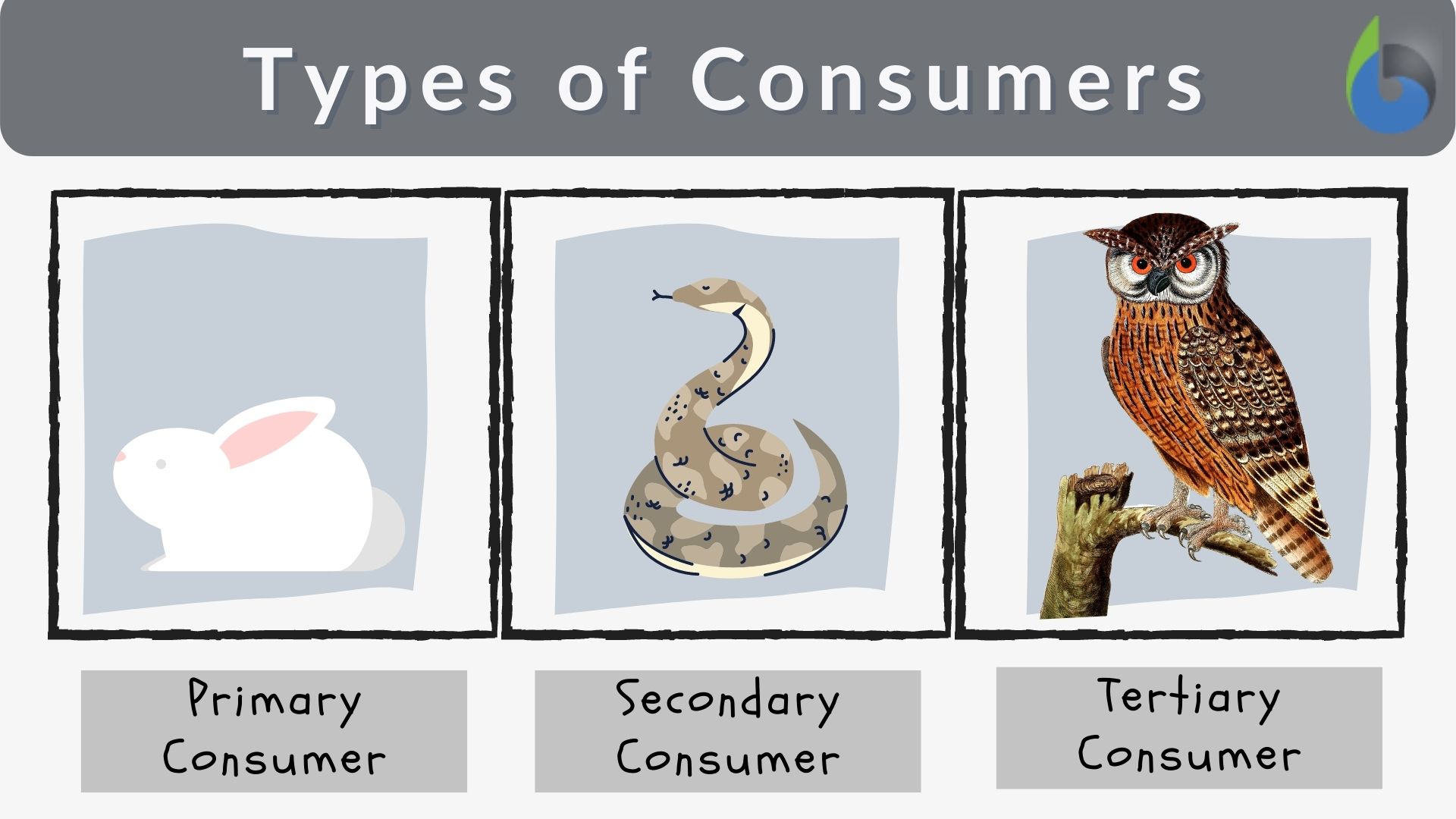
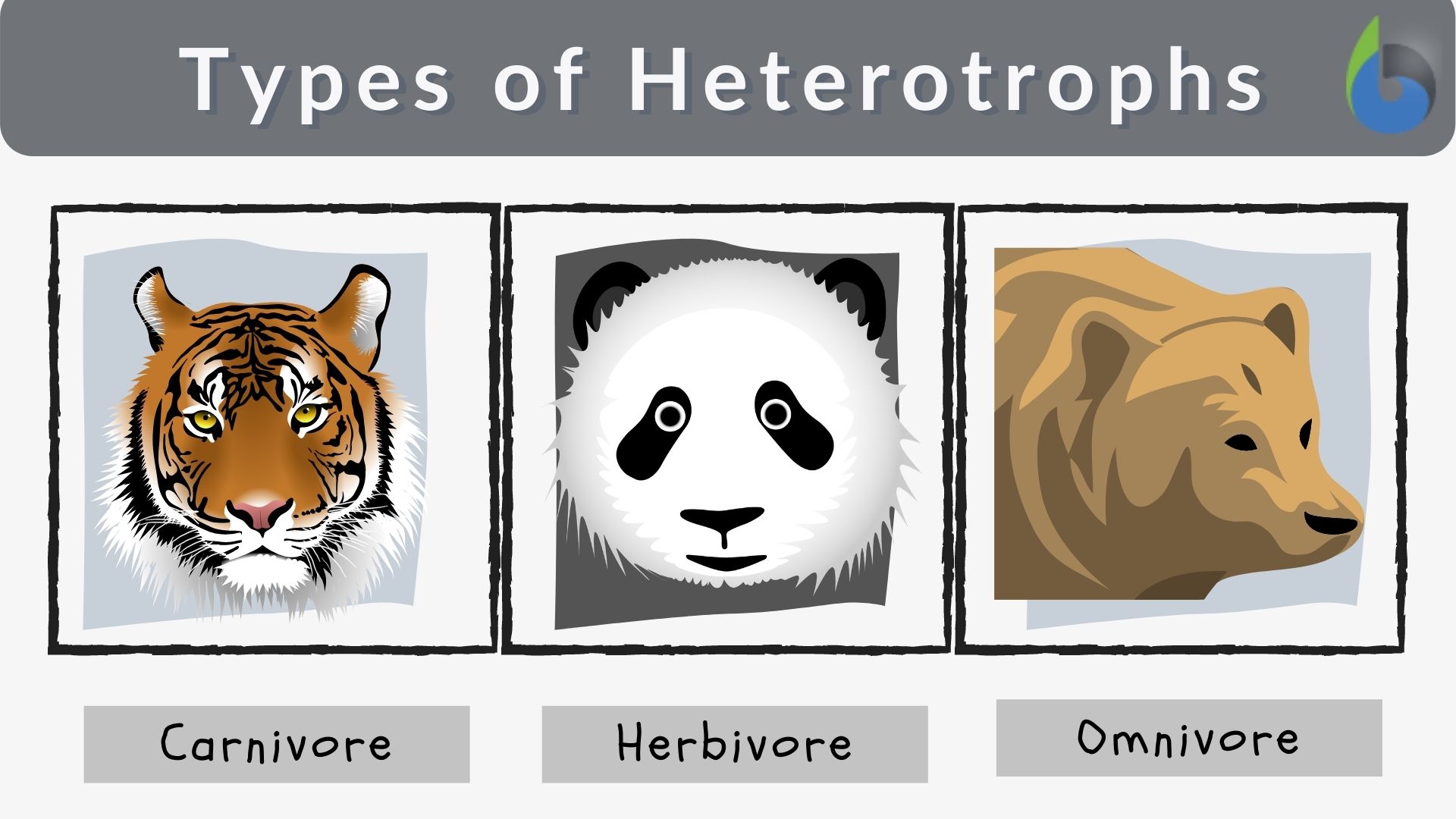
Heterotrophs are further classified into lithotrophs and organotrophs. Lithoheterotrophs use non-organic sources of food such as sulfur, ammonium, etc. to obtain electrons. Organotrophs use fats, carbohydrates, and proteins from plants and animals.
Consumers are also categorized based on the energy source they consume. A chemoheterotroph consumes chemicals for its energy need (as already described above). Examples include humans, animals, and mushrooms.
There are some heterotrophs that require light for energy and are known as photoheterotrophs. An example of such an organism is the green non-sulfur bacteria.
Most of the heterotrophs are chemoorganoheterotrophs. They use organic carbon as their carbon source and organic chemicals such as proteins, carbohydrates, and lipids as their electron source.
Contrary to the autotrophs that produce complex products, such as carbohydrates, fats, lipids, etc., the heterotrophs have the ability to break down these complex organic compounds. For example, carbohydrates are converted to glucose, proteins into amino acids, and fats into glycerol and fatty acid. The products after break down are water, carbon dioxide, and energy.
Heterotrophs can digest the organic compounds using fermentation, aerobic respiration, or anaerobic respiration. Mammals, birds, reptiles, and other animals use cellular respiration to digest food. The adenosine triphosphate is a chemical compound that provides energy to drive various processes in the living cells. The production of adenosine triphosphate in aerobically-respiring animals is coupled with oxidative phosphorylation (a process in which oxidation and phosphorylation occur simultaneously).
To learn about respiration at the cellular level, read: Cellular Respiration
Decomposers
Decomposers are the biotic factor in the environment that decomposes the plants, animals, and feces of animals. By decomposing these complex compounds, the detritivores get their nutrients. These include vertebrates, invertebrates, and some plants that rely on corpses, the remains of animals and plants, and waste materials.
The decomposers as biotic factors contribute by taking a role in the decomposition and in the recycling of the nutrients (nutrient cycles). They are an important part of the ecosystem because they break down complex molecules into simpler ones that can be used again by other organisms, including the producers. Examples of detritivores are fungi, soil bacteria, flies, worms, and other organisms.
Decomposers are placed at the bottom of the energy pyramid and other levels. The decomposers do not just include bacteria; they also include the arthropods that can take larger chunks of organic matter and convert it into smaller ones for bacteria to work on it. The other examples of detritivores are millipedes, slugs, woodlice, springtails, dung fly, sea stars, fiddle crabs, etc.
Detritivores are different from consumers because consumers usually consume the other organisms while they are alive while detritivores consume them once they are dead. The consumer biotic factor will not eat a rotting animal or fruit. Rather, detritivores metabolize the waste products and rotting organic compounds.
During the decomposition of dead animals or plants, these organisms get their energy and nutrients. Composting is a process that involves detritivores to decompose the waste of plants and animal waste (dung). During composting, the material is converted into useful fertilizer. The detritivores involved in this process are usually bacteria. The flies and worms also thrive in this environment.
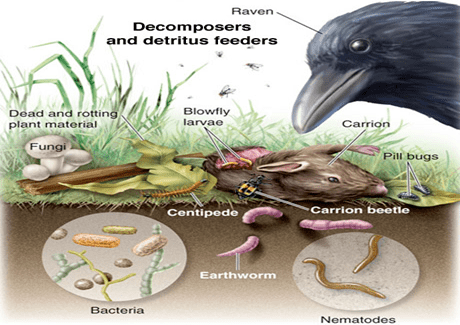
The decomposers can be categorized based on their size and biomes. The larger organisms such as millipedes and slugs are referred to as macro-detritivores whereas the smaller organisms, like bacteria, are referred to as micro-detritivores. The feeding behavior of detritivores is highly affected by rainfall. Detritivores thrive the most in moist environments.
Biotic Factors Examples
There are many examples of primary producers type biotic factors on Earth. The gross primary producer biotic factors are plants and trees. They employ photosynthesis to capture energy from the environment and produce it in some other preservable form. Apart from plants and trees, coral, algae, and bacteria are also important producers of an ecosystem.
The primary producer takes energy from the sun and produces sugar, fats, or proteins. Without the presence of producers, there would be no other life as it is seen today. These biotic factors are fundamental to the food chains of all ecosystems on earth. For example, a tree produces fruits that can be consumed by humans.
The same tree also converts carbon dioxide from the air to oxygen during the process of photosynthesis. Moreover, the plant also stores energy, which can be used as fuel. Therefore a single producer is producing more than one factor of life on earth.
Other examples of biotic factors are cyanobacteria, which are prokaryotic cells capable of making their food in the presence of sunlight. Cyanobacteria are believed to have evolved from the earliest prokaryotes that thrived in the absence of atmospheric oxygen.
Their ancestors acquired the ability to utilize the energy from the sun and inorganic gas, i.e. carbon dioxide, to release oxygen as they manufacture their own food. Initially, due to no oxygen, ultraviolet rays were reaching the earth thus making it impossible for any DNA to form or survive. When oxygen was eventually produced, it was converted into ozone, which over time accumulated and formed a protective layer in the upper atmosphere.
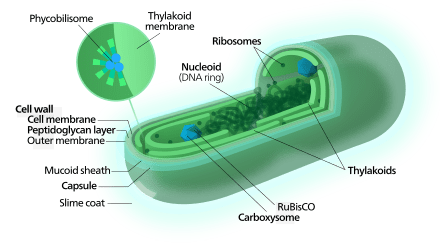
The disturbances in biotic factors can lead to serious consequences. One such example is North American wolves, which were hunted to extinction. As a result, the population of deer and other herbivores increased to a great extent. It seems good that humans will hunt these animals and consume their meat, however, the population increased so much that it started eating almost every crop, plant, and grass in that area.
Humans have to hunt these herbivores not to eat but to save their crops. Finally, wolf hunting was banned and wolves bred in captivity were released to restore the balance of biotic factors in the ecosystem. This shows the importance of the interaction of various biotic factors in the ecosystem.
For more examples, see this video below to understand the interactions of biotic factors or biotic relationships in the ecosystems.
Try to answer the quiz below to check what you have learned so far about biotic factors.
Further Reading
References
- Bonvville, H. (2019). Heterotroph — Definition & Examples. Retrieved April 7, 2021, from https://www.expii.com/t/heterotroph-definition-examples-10068
- GDMCE. (2019). Autotrophic Nutrition. Retrieved April 7, 2021, from https://gdmce.wordpress.com/2019/04/02/autotrophic-nutrition/
- Microbenotes. (2021). Biotic Factors- Definition, Types, Examples and Factors Affecting. Retrieved April 7, 2021, from https://microbenotes.com/biotic-factors/
- Singh, D., Kaur, G., Singh, J., & Satija, S. (2020). Microbial Strategies for Controlling Harmful Cyanobacterial Blooms, 189–204. https://doi.org/10.1007/978-981-15-2817-0_8
©BiologyOnline.com. Content provided and moderated by Biology Online Editors.

